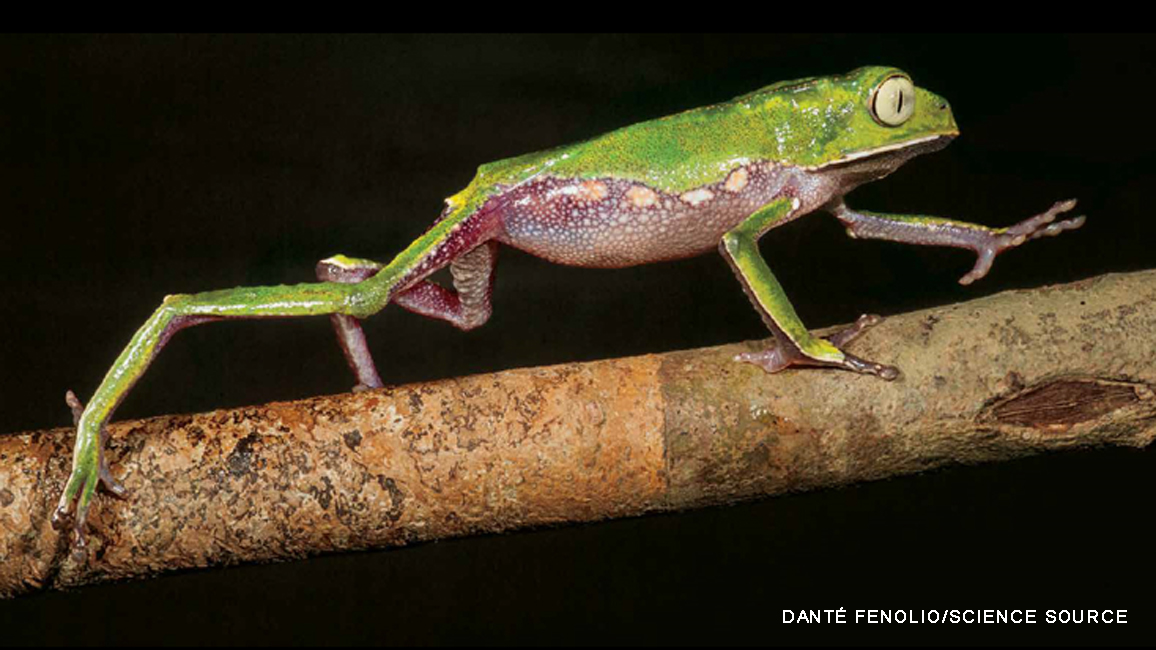
Wonderful World of Frogs
By Ellen LambethThey have big eyes and big mouths. They hop. They plop. They come in all shapes, sizes, and colors. Welcome to the wonderful world of frogs!

IT TAKES ALL KINDS
Frogs of one kind or another live just about anywhere. You’ll find them in towns and countrysides; in woods, meadows, and, of course, wetlands; even on mountains and in deserts. And each kind is especially suited to its particular home and lifestyle.
That’s why it’s no surprise that different kinds of frogs can look and act so differently. Size-wise, for example, they vary from the cat-sized goliath frog of western Africa to a fly-sized frog found on an island of the South Pacific. This tiny frog is so recently discovered, it doesn’t yet have a common name.
FROG OR TOAD?
People often think of frogs as having long, lean legs for leaping and smooth, thin skin. They also assume frogs usually live in or near water. In contrast, people describe toads as having short, squat legs for hopping and tough, bumpy skin. They also say toads live mostly on dry land. All that is pretty much OK to believe. But the truth is, toads are frogs, too—just frogs of a certain sort.

TAKE A LOOK
Frogs can’t move their eyeballs the way you can. They also can’t turn their heads. But with their big, bulging eyes perched on top, they can still get a pretty good look around.
Like you, a frog has eyelids. But each eye also has an extra see-through lid called a nictitating (NIK-tuh-tay-ting) membrane. The special lids protect and moisten the eyes while still allowing the frog to see. They also help disguise the eyes so hungry predators don’t notice a froggy snack to attack.
SCRUNCH, MUNCH
Many kinds of frogs have long, sticky tongues attached at the front of their mouths. If the frog spots an insect or other prey, it shoots the tongue out to snatch it. Once the prey is in the mouth, the frog pulls its eyeballs down into its head to help push the prey down the throat. Gulp!
VIDEO: WATCH HOW A FROG’S EYEBALLS HELP IT SWALLOW!
THE SKIN IT’S IN
Frogs don’t drink water—they absorb it through their skin. And even though they have lungs for breathing air, they also absorb oxygen from water through the skin. The skin produces slimy stuff called mucus (MYOO-kuss). The mucus holds in moisture, which helps the skin breathe. It also has chemicals in it that help keep out germs.
FROGGY GOES A-COURTIN’
Once winter moves into spring, you may start to hear a special evening chorus. That would be the peeps, trills, and croaks of male frogs calling for mates. Each kind of frog has its own kind of call. The frogs can tell who’s who—and, with practice, so could you!
The male has a vocal sac (or two) under his chin. When he fills it with air, it blows up like a balloon and makes his call sound louder.
GROWING UP FROG
During breeding season, the females of most frogs lay their eggs in water as the males fertilize them. Usually, a fish-like tadpole hatches from each egg. Soon it begins to change. Back legs appear first. Then front legs appear, and the tail shrinks. Finally, the tail is gone, and the animal can breathe air and move on land as a little frog. This process of change is called metamorphosis (metuh-MOR-fuh-suss).

A FEW FREAKY FROGS
1. Not all frogs are green. Most have colors that blend in with their surroundings. But some, such as this golden poison frog, stand out. Their bright colors are a warning that their mucus may be deadly.
2. The Titicaca water frog (named for the South American lake it lives in) has saggy, wrinkly skin that looks like an oversized suit. But all those extra skin folds help absorb more oxygen from the water. That lets the frog stay underwater an extra-long time.
3. The shovel-shaped snout on this casque-headed treefrog is like a bony helmet. The frog hides out in tree holes and uses its hard head to plug the openings.
4. Don’t step on that pointy leaf! It’s really a Malayan horned frog that matches the fallen leaves in its forest home.
BE A FROG SCOUT!
What frogs live near you? Now’s the time to get out with an adult and find out. Frogs are on the lookout for wet places to find mates and lay eggs, so you should be on the lookout, too. Be prepared to get wet—and maybe even a little muddy! Here are a few tips:
- Listen for frogs calling for mates.
- Check for eggs and tadpoles in water.
- See if you can sneak up on a frog before it plops into the water.
- If you try to catch a frog, first make sure your hands are wet and free of any chemicals. That will help protect the frog’s fragile skin. Keep the frog close to the ground, in case it gets away. After checking it out, let it go where you found it.
- A headlamp or flashlight will help you find frogs at night, when many are most active.
- Use a frog field guide to help you ID your finds.Become a citizen scientist by joining FrogWatch USA! By keeping track of the frogs in your area and sharing your information, you can help frog scientists figure out how different species are doing across the country. Have an adult visit aza.org/frogwatch for more information.
















